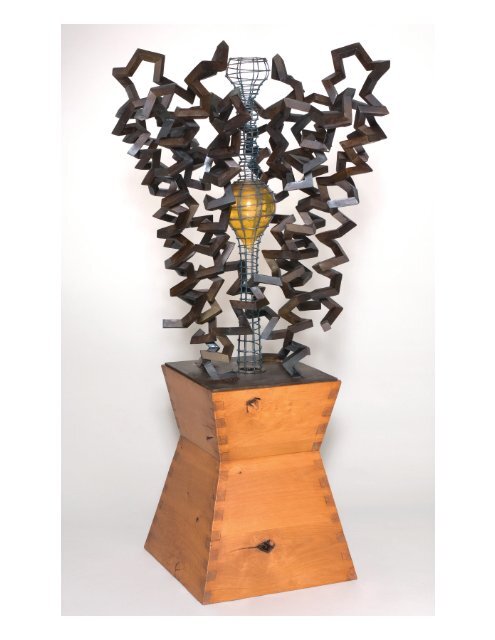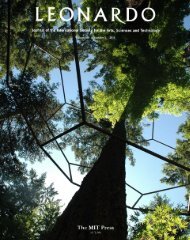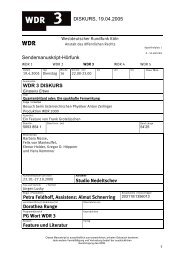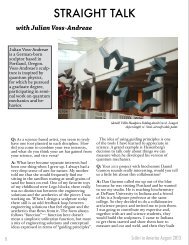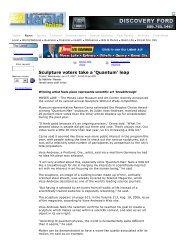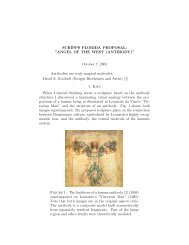Sculpture Inspired by Proteins - Julian Voss-Andreae
Sculpture Inspired by Proteins - Julian Voss-Andreae
Sculpture Inspired by Proteins - Julian Voss-Andreae
You also want an ePaper? Increase the reach of your titles
YUMPU automatically turns print PDFs into web optimized ePapers that Google loves.
a r t i s t ’ s a r t i c l e<br />
Unraveling Life’s Building Blocks:<br />
<strong>Sculpture</strong> <strong>Inspired</strong> <strong>by</strong> <strong>Proteins</strong><br />
a b s t r a c t<br />
There are a number of common themes woven<br />
through the fabric of my sculptural work. One such theme is<br />
the idea of the fundamental building block, the smallest unit<br />
that, upon assembly, displays an extraordinary transformation<br />
from geometric simplicity to organic complexity. Some of my<br />
recent work was inspired <strong>by</strong> quantum physics, the study of the<br />
building blocks of the physical world [1,2]. A larger body of<br />
work, begun in 2001 after I switched careers from quantum<br />
physics to art, is concerned with the structure and conceptual<br />
potential of proteins, the molecular building blocks of all life<br />
forms. This article presents a selection of these works, complementing<br />
others that I have described earlier [3]. The article’s<br />
final section places the work in the context of contemporary<br />
efforts that aim at expanding the current paradigm beyond<br />
the confines of scientific reductionism.<br />
<strong>Julian</strong> <strong>Voss</strong>-<strong>Andreae</strong> (artist/scientist), 1517 SE Holly Street, Portland, OR 97214, U.S.A.<br />
E-mail: . Website: .<br />
See for supplemental files associated with<br />
this issue.<br />
Article Frontispiece. Birth of an Idea, steel, colored glass, and wood,<br />
60 × 32 × 32 in (150 × 80 × 80 cm), 2007. (© <strong>Julian</strong> <strong>Voss</strong>-<strong>Andreae</strong>.<br />
Photo © Dan Kvitka. Collection of Roderick MacKinnon, Rockefeller<br />
University, New York City, N.Y.) This sculpture is based<br />
on the structure of the potassium channel protein. Roderick Mac-<br />
Kinnon, who commissioned Birth of an Idea, won the 2003 Nobel<br />
Prize in Chemistry for his work on this structure and provided the<br />
experimental data that were used as a starting point to create this<br />
sculpture. For a color image see the artist’s website [30].<br />
<strong>Julian</strong> <strong>Voss</strong>-<strong>Andreae</strong><br />
Protein <strong>Sculpture</strong>s<br />
When we cut an organism into parts small enough to be handled<br />
intellectually, we both literally and emotionally lose its<br />
essential property of being alive. Perceiving the parts of a living<br />
being as inanimate often lets us presume that the “aliveness”<br />
of the whole being is just an illusion. But perhaps the opposite<br />
is true: Because the whole is alive, all its parts are in the<br />
same sense alive and should therefore be worthy of an equal<br />
emotional attachment. Among the smallest molecular parts<br />
specific to life are the proteins. It is through proteins that life<br />
accomplishes the transition from one-dimensional DNA, the<br />
carrier of genetic information, to three-dimensional organisms<br />
[4]. <strong>Proteins</strong> are chains of amino acids arranged in a specific<br />
sequence that is encoded in the DNA’s sequence of basepairs,<br />
the “rungs” on the DNA “ladder.”<br />
The structure of a protein is<br />
largely determined <strong>by</strong> its sequence<br />
of amino acids. Inherently still<br />
one-dimensional, the linear molecular<br />
chain folds into an often welldefined,<br />
three-dimensional object.<br />
I use the application of compound<br />
mitered cuts, the rotation of every<br />
other part, and subsequent reconnection<br />
as an elegant way to recreate<br />
the structure of proteins from<br />
the ubiquitous one-dimensional<br />
<strong>Inspired</strong> <strong>by</strong> proteins, the<br />
molecular building blocks of<br />
life, the author’s presented work<br />
re-creates the first step of the<br />
emergence of three-dimensional<br />
bodies from one-dimensional<br />
DNA. Utilizing an algorithmic<br />
approach as his point of departure,<br />
the artist follows his vision<br />
freely, creating sculptures that<br />
bring life’s isolated components<br />
emotionally back to life. In this<br />
sequel to an earlier Leonardo<br />
article on the inception of his<br />
protein-inspired sculptures, the<br />
author presents the unfolding<br />
of his vision: Large-scale works<br />
of increasing formal and conceptual<br />
complexity display the<br />
emergence of an organic aesthetic<br />
from geometric elements<br />
and inspire a more holistic view<br />
of nature than that provided <strong>by</strong><br />
reductionist science alone.<br />
building materials, such as lumber or steel tubing. My process<br />
is to search for proteins with determined structures that have<br />
aesthetic as well as conceptual appeal. After downloading the<br />
structural data, I run a custom-developed computer algorithm<br />
to generate the cutting instructions that provide the starting<br />
point for my sculptures (see Fig. 1). The basic ideas and processes<br />
are described in detail elsewhere [5,6].<br />
Due to the inherent properties of the miter-cut representation,<br />
sculptures based on smaller proteins evoke the impersonal<br />
aesthetic language of modernist sculpture [7]. A good<br />
example is Alpha Helix for Linus Pauling [8] (Color Plate C<br />
[d] and Fig. 1[d]) based on a 15-amino-acid sequence. As the<br />
number of amino acids increases to several hundreds or even<br />
thousands, an exciting transition takes place: The cold and<br />
crystalline feel of a small number of polyhedral faces gives way<br />
to something that feels “warmer,” and the much more complex<br />
aesthetics of the organic world starts to emerge.<br />
Light-Harvesting Complex<br />
Plants and photobacteria (bacteria capable of photosynthesis)<br />
absorb sunlight, there<strong>by</strong> providing us and virtually all other<br />
creatures with the energy and low entropy we need to maintain<br />
life. Photobacteria possess a beautiful and well-understood<br />
photosynthetic apparatus embedded in their cell membranes.<br />
Instrumental to the initial absorption of the light is a structure<br />
known as the light-harvesting complex, an array of two concentric<br />
rings of proteins. Coiled protein segments traverse the<br />
cell membrane and hold light-absorbing pigments in between<br />
the rings. Intrigued <strong>by</strong> both its structure and its function, I<br />
created a sculpture based on the light-harvesting complex.<br />
Each of the two protein rings is made up of nine identical subunits,<br />
which I portrayed using ½-in-diameter (13-mm) wooden<br />
dowels. The whole complex consists of 850 amino acids, corresponding<br />
to the same number of one-inch-long (25 mm)<br />
pieces of wood. Each protein subunit is anchored in position<br />
© 2013 ISAST LEONARDO, Vol. 46, No. 1, pp. 12–17, 2013 13
Fig. 1. One protein depicted in four different ways. (© <strong>Julian</strong> <strong>Voss</strong>-<strong>Andreae</strong>) The figure shows a coiled amino acid sequence known as an<br />
alpha helix, commonly found in many proteins. Panel (a) depicts the alpha helix as a “space fill” model: All (non-hydrogen) atoms of the<br />
molecule are drawn as intersecting spheres. Panel (b), a “ball-and-stick” model, has smaller atoms that are connected <strong>by</strong> rods to indicate<br />
the chemical bonds. Panel (c), the “ribbon” model, reduces the protein to its backbone, which is depicted as a smoothened ribbon in space.<br />
Panel (d) shows the alpha helix as a miter-cut object; this technique was used for the sculptures presented here. Instead of being presented<br />
with the backbone smoothed into a curve, each amino acid corresponds to a straight miter-cut piece. Compare this image to Color Plate C(d),<br />
a photo of an actual sculpture created after the same computer model. Panels (a–c) were generated using the molecular graphics visualization<br />
software RasMol [31] and panel (d) was generated using my own software.<br />
in a layer of transparent casting resin on<br />
a wooden disc. The sculpture is placed<br />
on the floor of a dimly lit room so that<br />
the structure casts moving shadows on<br />
the wall (see Fig. 2). The shadows evoke<br />
plants moving in the wind. It seems as if<br />
the macroscopic plants of our world have<br />
become ephemeral shadows, while the<br />
microscopic, and ordinarily not perceivable,<br />
basis for their existence has become<br />
the tangible object [9–11].<br />
Unraveling Collagen<br />
One of the many helical structures of vital<br />
importance to us is collagen, our bodies’<br />
most abundant protein. In collagen,<br />
three amino acid spirals, reminiscent of<br />
a rope, wind around each other to create<br />
a meta-spiral. Collagen mainly provides<br />
our bodies with structural support<br />
[12]. In a sculpture inspired <strong>by</strong> collagen,<br />
I emphasized its structural function <strong>by</strong><br />
reducing each of the sculpture’s faces to<br />
a cross-braced outline to reveal the dominant<br />
force lines in a way that resembles<br />
many modern steel buildings, utilitarian<br />
structures and bridges. For aesthetic and<br />
conceptual reasons, I departed from the<br />
actual molecular structure <strong>by</strong> opening up<br />
the intertwining helices toward the top<br />
(Fig. 3). In this way, the sculpture also<br />
becomes a metaphor for aging [13,14]:<br />
It is the degradation of collagen that<br />
famously leads to the wrinkles that accompany<br />
aging. At the same time, the<br />
playful upward movement of the sculpture<br />
imparts a sense of aging as growth,<br />
a journey toward completion, where<br />
“unraveling” becomes “unfolding”: the<br />
fulfillment from innate potential into<br />
reality.<br />
Heart of Steel<br />
Hemoglobin, the oxygen-carrying molecule<br />
that gives our blood its red color,<br />
is another well-known protein of vital<br />
importance to our existence. Its color<br />
stems from iron atoms, which are essential<br />
in capturing oxygen from the air<br />
and distributing it to the whole body. I<br />
created a sculpture based on the hemoglobin<br />
structure and alluded to the basis<br />
of our body’s ability to breathe <strong>by</strong> letting<br />
a similar reaction occur on the artwork’s<br />
surface: Initially sanded to a bright, silvery<br />
sheen, the steel sculpture started<br />
forming a reddish oxide layer soon after<br />
its unveiling at an outdoor gallery.<br />
As the sculpture’s entire body became<br />
successively saturated with oxygen, it<br />
acquired an increasingly deeper coloration<br />
[15,16] (Color Plate C[a–c]). The<br />
intricately shaped steel piece is complemented<br />
<strong>by</strong> a large, blood-red glass sphere<br />
in its center, evoking the image of a drop<br />
of blood [17]. The sculpture reacts sensitively<br />
to wind and touch, answering each<br />
push with an unexpected shiver, echoing<br />
the complex vibrational dynamics of<br />
large biomolecules [18].<br />
Nanos<br />
The small protein microcin, synthesized<br />
<strong>by</strong> a certain strand of the common intestinal<br />
bacterium E. coli, features a most<br />
unusual structure, resembling a lasso<br />
whose tail folds over and enters the<br />
noose. It is this knotted structure that<br />
kills off other bacteria <strong>by</strong> interfering with<br />
its victims’ protein synthesis machinery<br />
[19]. Nanos, named after the Greek word<br />
for “dwarf,” is a 6-ft-tall (1.80 m) sculpture<br />
based on microcin’s structure. In addition<br />
to referring to the nanoscale these<br />
molecules inhabit, the name hints at the<br />
anthropomorphic character of the sculpture,<br />
with the noose on top evoking an<br />
oversized head (Fig. 4). It is remarkable<br />
how much the sculpture resembles abstract<br />
modernist sculpture, even though<br />
it is, strictly speaking, representational. I<br />
emphasized this resemblance <strong>by</strong> giving<br />
the stainless steel the irregular sander<br />
finish pioneered <strong>by</strong> American abstract<br />
expressionist sculptor David Smith,<br />
which has influenced subsequent generations<br />
of artists and designers and has<br />
since become associated with the look of<br />
modernist sculpture.<br />
Birth of an Idea<br />
In 2007 I completed a sculpture (Article<br />
Frontispiece) based on the structure of<br />
an ion channel protein for Roderick<br />
MacKinnon, who received the 2003 Nobel<br />
Prize in Chemistry for his seminal<br />
work on such a molecule. Found in the<br />
nerve cells that make up our brain and<br />
its nervous connections to the rest of our<br />
body, ion channels control the passage of<br />
specific atoms through the nerve cells’<br />
14 <strong>Voss</strong>-<strong>Andreae</strong>, Unraveling Life’s Building Blocks
Fig. 2. Light-Harvesting Complex, wood, casting resin, and candle, 22 × 25 × 25 in (56 × 64 × 64 cm), 2003. (© <strong>Julian</strong> <strong>Voss</strong>-<strong>Andreae</strong>) The left<br />
panel is a top view showing the two concentric rings of alpha helical proteins. A candle placed in the center of the structure serves as the only<br />
light source. The right panel shows a side view, with the helical structures casting moving shadows on the wall of the small chamber where the<br />
piece is displayed.<br />
membranes. Intimately connected to our<br />
intellectual and emotional responses to<br />
the world, this mechanism is at the very<br />
foundation of the living nerve cells’<br />
characteristic activity, the filtering and<br />
relaying of information through selective<br />
firing. When I was commissioned to create<br />
this sculpture, I was inspired <strong>by</strong> the<br />
ion channel’s potential to symbolize the<br />
“spark,” the small but all-important idea<br />
at the beginning of everything we do. Although<br />
we will probably never be able<br />
to point at one structure in our brain<br />
where that proverbial spark emerges, the<br />
ion channel provides a beautiful metaphor<br />
for it because it functions as the<br />
smallest logical unit in the vast network<br />
of our brain. <strong>Inspired</strong> <strong>by</strong> depictions of<br />
the potassium channel’s interior [20], I<br />
created an object welded from steel wire<br />
to represent the pore’s cavity. This pore<br />
object, surrounded <strong>by</strong> a protein scaffold<br />
made from blackened steel, is lacquered<br />
in a translucent blue. Like an isodensity<br />
plot of a molecule’s electron density<br />
[21], the pore object features bulges<br />
at the locations the ions populate during<br />
their single-file passage through the<br />
protein. The largest bulge corresponds<br />
to the channel’s main cavity, where the<br />
ion’s surrounding water molecules are<br />
stripped off to be replaced <strong>by</strong> specific<br />
protein atoms. The main cavity contains<br />
a yellow blown-glass bubble, evocative of<br />
a rising balloon. The sculptural pedestal<br />
is fabricated from hand-planed, oneinch-thick<br />
(2.5 cm) wooden boards connected<br />
<strong>by</strong> the ancient technique of finger<br />
joints, mirroring the fourfold rotational<br />
symmetry of the protein.<br />
Angel of the West<br />
When I was doing research for a sculpture<br />
based on the structure of our<br />
immune system’s key molecule, the antibody,<br />
I noticed an interesting similarity<br />
between this molecule and the human<br />
body, in both proportion and function:<br />
Shaped like a “Y,” the antibody features a<br />
pair of identical protrusions, resembling<br />
arms, that are able to move <strong>by</strong> means of<br />
a flexible region in the molecule’s center.<br />
These “arms” end in “hands,” highly spe-<br />
Fig. 3. Unraveling Collagen, stainless steel, height 11 ft 3 in (3.40 m), 2005. (© <strong>Julian</strong> <strong>Voss</strong>-<br />
<strong>Andreae</strong>) <strong>Inspired</strong> <strong>by</strong> the most abundant protein in our bodies, Unraveling Collagen is based<br />
on the collagen structure. In contrast to the tightly coiled molecular structure, the sculpture’s<br />
three strands unravel toward the top.<br />
<strong>Voss</strong>-<strong>Andreae</strong>, Unraveling Life’s Building Blocks 15
cific regions that hold on to an intruder,<br />
for example a virus particle, there<strong>by</strong> tagging<br />
it for destruction through the immune<br />
system. In order to allude to the<br />
similarity between man’s body and his<br />
Fig. 4. Nanos,<br />
stainless steel,<br />
height 6 ft (1.80<br />
m), 2006. (©<br />
<strong>Julian</strong> <strong>Voss</strong>-<br />
<strong>Andreae</strong>. Collection<br />
of Shari and<br />
Alan Newman,<br />
Lake Oswego,<br />
OR.) While<br />
resembling an<br />
abstract modernist<br />
sculpture,<br />
Nanos, like all<br />
other sculptures<br />
presented in this<br />
article, is actually<br />
representational.<br />
Its shape is based<br />
on the unusual<br />
structure of a<br />
small antibacterial<br />
protein.<br />
Fig. 5. Antibody<br />
Structure<br />
Superimposed<br />
on Leonardo’s<br />
Vitruvian Man,<br />
computer sketch<br />
of the idea for<br />
Angel of the West,<br />
2006. (© <strong>Julian</strong><br />
<strong>Voss</strong>-<strong>Andreae</strong>)<br />
Eduardo Padlan’s<br />
1994 composite<br />
model<br />
of the antibody<br />
molecule was<br />
superimposed<br />
on Leonardo’s<br />
1490 Vitruvian<br />
Man, revealing<br />
a striking resemblance<br />
between<br />
man’s body and<br />
his antibody, in<br />
proportions as<br />
well as function.<br />
antibody, I designed the sculpture to subtly<br />
evoke a Renaissance icon deeply anchored<br />
in popular culture: Leonardo da<br />
Vinci’s 1490 study of the human proportions,<br />
Vitruvian Man. When I superimposed<br />
the frontal view of the antibody’s<br />
1,336-amino-acid structure, as provided<br />
<strong>by</strong> Eduardo Padlan [22], onto the Vitruvian<br />
Man, I was struck <strong>by</strong> the fact that<br />
the two images coincide perfectly (Fig.<br />
5). For my design, I decided to utilize this<br />
powerful similarity and let the antibody<br />
molecule stand in place of Leonardo’s<br />
man while turning the surrounding<br />
circle into a tapered ring. I then added<br />
thin rods under the arms radiating out<br />
from the position where the center of the<br />
head was located in the drawing. This set<br />
of rays emanating from a central source<br />
makes the design reminiscent of spiritual<br />
imagery [23]. With the wing-shaped<br />
“arms” added, the image is evocative of<br />
an angel (Color Plate C[e]) [24]. Our<br />
antibodies can, in fact, be viewed as legions<br />
of tiny guardian angels, constantly<br />
protecting us from disease. Their ability<br />
to bind very specifically to certain molecules<br />
is also the reason the antibody molecule<br />
has become an indispensable tool<br />
in biomedical research, crucial for understanding<br />
the machinery of life [25]. I<br />
chose the name Angel of the West as a play<br />
on Antony Gormley’s monumental sculpture<br />
Angel of the North (1998), in Gateshead,<br />
U.K. The “West” in my sculpture<br />
is a reference to the Western approach<br />
to healing through the tools of Western<br />
science. The fabrication of the sculpture<br />
resembled a gigantic three-dimensional<br />
puzzle with about 1,400 pieces, laser-cut<br />
from steel sheet of varying thicknesses to<br />
fit the structural requirements [26].<br />
Art and Scientific<br />
Reductionism<br />
Despite our increasingly heavy reliance<br />
on science-derived technology, only a<br />
minority of people today recognize science<br />
as a vital part of human culture or<br />
have experienced feelings of wonder<br />
from scientific observations in the same<br />
way as they would from, say, a beautiful<br />
sunset. After an era of relative faith in<br />
science, culminating in the immediate<br />
post–World War II era, the public’s attitude<br />
toward the natural sciences began<br />
to shift, starting around 1970 [27]. My<br />
generation, born during that time, grew<br />
up with a new sense of mistrust that was<br />
triggered <strong>by</strong> the growing suspicion that<br />
the reductionist approach inherent in<br />
science and technology, and its profound<br />
effects on our lifestyle, could not be separated<br />
from the global environmental and<br />
spiritual crisis that was then becoming increasingly<br />
apparent.<br />
Scientific reductionism, the assumption<br />
that complex systems can be completely<br />
understood through an under-<br />
16 <strong>Voss</strong>-<strong>Andreae</strong>, Unraveling Life’s Building Blocks
standing of their components, is deeply<br />
ingrained in the very structure of the<br />
natural sciences and has been an extraordinarily<br />
successful guiding principle in<br />
the West since the Age of Enlightenment<br />
[28]. Art, <strong>by</strong> contrast, is non-reductionist<br />
in its very nature: The profound effect<br />
of a great work of art cannot be comprehended<br />
<strong>by</strong> adding up the effects the<br />
work’s separated parts would have. Nor<br />
can that artwork’s impact be reduced to<br />
the intellectual knowledge of specific<br />
interpretations of it. True appreciation<br />
of art seems impossible in a frame of<br />
mind that clings to the object-subject<br />
dichotomy that has become so deeply<br />
entrenched in Western thinking for the<br />
past few centuries. According to Einstein,<br />
in art, “We show [what we behold and experience]<br />
in forms whose interrelationships<br />
are not accessible to our conscious<br />
thought but are intuitively recognized as<br />
meaningful” [29]. The presented works<br />
take the notion of artistic counter-reductionism<br />
to another level: Departing<br />
from a mere structural representation<br />
of proteins, the exemplary specimens<br />
of reductionist biology, these works take<br />
living beings’ components, typically<br />
considered inanimate, and bring them<br />
metaphorically back to life. In this way,<br />
these sculptures, born from scientific<br />
data, are capable of imparting an artistic<br />
experience of life that complements the<br />
understanding provided <strong>by</strong> reductionist<br />
science alone and there<strong>by</strong> inspire a more<br />
holistic view of nature.<br />
Acknowledgments<br />
I would like to thank the people who have allowed<br />
me to do this work: Insbesondere meinen lieben Eltern<br />
Si<strong>by</strong>lle and Peter <strong>Voss</strong>-<strong>Andreae</strong>, as well as the<br />
collectors and patrons who have supported my work.<br />
I am also indebted to George Weissmann, Colin J.<br />
Thomas and the Leonardo reviewers for contributing<br />
ideas. And last but not least, I want to thank my beloved<br />
wife Adriana for continually inspiring me and<br />
for her great help with this manuscript.<br />
References and Notes<br />
Unedited references as provided <strong>by</strong> the author.<br />
1. J. <strong>Voss</strong>-<strong>Andreae</strong>, “Quantum <strong>Sculpture</strong>s: Art <strong>Inspired</strong><br />
<strong>by</strong> the Deeper Nature of Reality,” Leonardo<br />
44 1 (2011).<br />
2. P. Ball, “Quantum Objects on Show,” Nature 462<br />
(2009) p. 416 .<br />
3. J. <strong>Voss</strong>-<strong>Andreae</strong>, “Protein <strong>Sculpture</strong>s: Life’s Building<br />
Blocks Inspire Art,” Leonardo 38 1 (2005) pp.<br />
41–45.<br />
4. I use the term “n-dimensional” (where n = 1, 2, 3)<br />
in this article as it is commonly used to describe objects<br />
of the real world (as opposed to mathematical<br />
entities): An object is n-dimensional if it extends significantly<br />
only into n of the 3 dimensions of physical<br />
space. Its extent into the remaining 3−n dimensions is<br />
negligible compared to its extent into the other n dimensions,<br />
i.e. smaller <strong>by</strong> some orders of magnitude.<br />
5. J. <strong>Voss</strong>-<strong>Andreae</strong> [3].<br />
6. J. <strong>Voss</strong>-<strong>Andreae</strong>, BFA thesis paper: Protein <strong>Sculpture</strong>s<br />
(Saarbrücken: Lambert Academic Publishing,<br />
2010) .<br />
7. <strong>Voss</strong>-<strong>Andreae</strong> [6], chapter 5.1.<br />
8. J. <strong>Voss</strong>-<strong>Andreae</strong> [3].<br />
9. A. Chugunov, “Изваяние Невидимого (Invisible<br />
Monuments),” Computerra 45 713 (2007) pp. 26–28<br />
.<br />
10. “<strong>Julian</strong> <strong>Voss</strong>-<strong>Andreae</strong>, Protein Sculptor (interview),”<br />
PDB Newsletter 32 (2007) .<br />
11. <strong>Voss</strong>-<strong>Andreae</strong> [6] chapter 4.3.<br />
12. The symptoms of scurvy drastically illustrate what<br />
happens to our bodies if, due to a lack of Vitamin<br />
C, we fail to keep up the regular synthesis of new<br />
collagen.<br />
13. J. Wallace, “Protein <strong>Sculpture</strong>s for the People,”<br />
AWIS Magazine (Spring 2008) pp. 14–17 .<br />
14. B. Wand, “‘Unraveling Collagen’ structure to be<br />
installed in Orange Memorial Park <strong>Sculpture</strong> Garden,”<br />
Expert Review of Proteomics 3 2 (2006) p. 174.<br />
15. P. Ball, “The Crucible,” Chemistry World 3<br />
(2008) pp. 42–43 .<br />
16. C. Abad-Zapatero, “Escultor de proteínas (Protein<br />
sculptor),” El País (19 September 2007) p. 45<br />
.<br />
17. I should note that this sculpture is not (nor is any<br />
of my work) intended to be a scientifically accurate<br />
model. For example, my placement of the red glass<br />
sphere in the center of the sculpture was a purely<br />
artistic decision and does not correspond to the location<br />
of the iron in the actual molecule.<br />
18. J. Couzin, “Blood and Steel,” Science 309 (2005)<br />
p. 2160.<br />
19. Vivienne B. Gerritsen, “Entanglement,” Protein<br />
Spotlight 72 (2006) .<br />
20. See Fig. 5(B) in D. Doyle et al., “The Structure<br />
of the Potassium Channel: Molecular Basis of K+<br />
Conduction and Selectivity,” Science 280 (1998), p.<br />
74; and Fig. 2 in Y. Zhou et al., “Chemistry of ion coordination<br />
and hydration revealed <strong>by</strong> a K+ channel-<br />
Fab complex at 2.0 Å resolution,” Nature 414 (2001),<br />
p. 45.<br />
21. Such structures’ “shape,” governed <strong>by</strong> quantum<br />
mechanics, is a spatial probability distribution of<br />
the likelihood of measuring an electron. In order to<br />
transform this kind of information into something<br />
we are accustomed to dealing with, scientists often<br />
visualize molecules through a pseudo-surface that is<br />
defined <strong>by</strong> a specific, constant likelihood of finding<br />
an electron, the “isodensity plot.”<br />
22. Eduardo A. Padlan, “Anatomy of the antibody<br />
molecule,” Molecular Immunology 31 3 (1994) pp.<br />
169–217.<br />
23. One of the images that guided my design was<br />
Gianlorenzo Bernini’s famous 1666 alabaster window<br />
at St. Peter’s Basilica, depicting the Holy Spirit as<br />
a dove.<br />
24. Images of angels, winged humans, date far back<br />
into pre-Christian times. A well-known example is the<br />
Nike of Samothrace, from about 200 BC.<br />
25. This makes the antibody an appropriate symbol<br />
for The Scripps Research Institute, which commissioned<br />
the sculpture as the signature piece for their<br />
new Florida campus.<br />
26. The creation and installation of the Angel of the<br />
West was covered <strong>by</strong> Oregon Public Broadcasting<br />
Television’s art series “Oregon Art Beat”: V. Patton<br />
(producer), “Quantum <strong>Sculpture</strong>s with <strong>Julian</strong><br />
<strong>Voss</strong>-<strong>Andreae</strong>,” Oregon Art Beat Oregon Public<br />
Broadcasting Television (18 December 2008) .<br />
27. Tor Nørretranders, Spüre die Welt. Die Wissenschaft<br />
des Bewußtseins (Reinbek bei Hamburg: Rowohlt,<br />
1997) Ch. 14.<br />
28. John Cornwell (ed.), Nature’s Imagination (Oxford,<br />
UK: Oxford Univ. Press, 1995) Ch. 6 <strong>by</strong> Gerald<br />
M. Edelman and Giulio Tononi.<br />
29. Quoted in H.-O. Peitgen and P.H. Richter, The<br />
Beauty of Fractals (Berlin: Springer-Verlag, 1986) p. 1.<br />
30. .<br />
31. .<br />
Manuscript received 13 April 2011.<br />
Initially trained as an experimental physicist,<br />
<strong>Julian</strong> <strong>Voss</strong>-<strong>Andreae</strong> is a German-born sculptor<br />
based in Portland, Oregon. His sculpture<br />
is critically acclaimed and has been commissioned<br />
<strong>by</strong> multiple institutions and private<br />
collectors in the U.S.A. and abroad.<br />
<strong>Voss</strong>-<strong>Andreae</strong>, Unraveling Life’s Building Blocks 17
Color Plate C<br />
<strong>Julian</strong> <strong>Voss</strong>-<strong>Andreae</strong>, (a–c) Heart of Steel, weathering steel and glass, height 5 ft (1.60 m), 2005. (© <strong>Julian</strong> <strong>Voss</strong>-<strong>Andreae</strong>) The<br />
images show a time-sequence of the hemoglobin-based sculpture’s metamorphosis: Photo (a) was taken right after unveiling,<br />
(b) after 10 days and (c) after several months of exposure to the elements. (d) Alpha Helix for Linus Pauling, powdercoated<br />
steel, 10 ft (3 m) high, 2004. (© <strong>Julian</strong> <strong>Voss</strong>-<strong>Andreae</strong>. Collection of The Linus Pauling Center for Science, Peace, and<br />
Health.) This memorial for Linus Pauling is located in front of Pauling’s childhood home in Portland, OR. (e) Angel of the<br />
West, stainless steel, 12 × 12 × 4 ft (3.70 × 3.70 × 1.20 m), 2008. (© <strong>Julian</strong> <strong>Voss</strong>-<strong>Andreae</strong>. Photo <strong>by</strong> James McEntee, courtesy<br />
of The Scripps Research Institute.) Commissioned as the signature sculpture of The Scripps Research Institute’s new campus<br />
in Jupiter, FL, this sculpture plays upon the striking similarity between the human body and our immune system’s key<br />
molecule, the antibody.<br />
39


